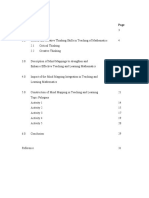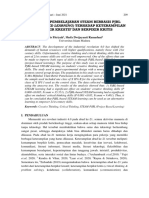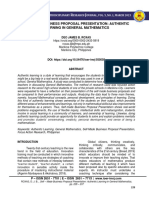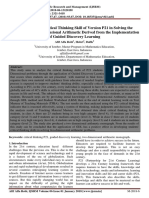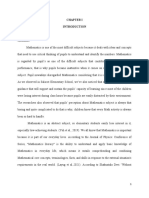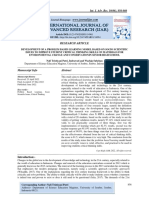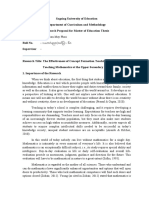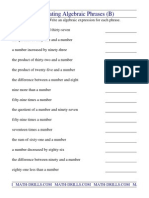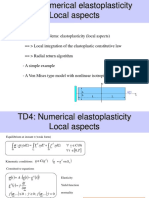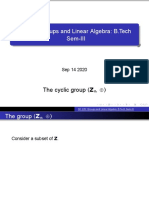Professional Documents
Culture Documents
Approaches To Enhance Mathematical Thinking To Realize NEP 2020 Vision For Young Learners
Original Title
Copyright
Available Formats
Share this document
Did you find this document useful?
Is this content inappropriate?
Report this DocumentCopyright:
Available Formats
Approaches To Enhance Mathematical Thinking To Realize NEP 2020 Vision For Young Learners
Copyright:
Available Formats
Volume 7, Issue 4, April – 2022 International Journal of Innovative Science and Research Technology
ISSN No:-2456-2165
Approaches to Enhance Mathematical Thinking to
Realize NEP 2020 Vision for Young Learners
Dr. Richa Aggarwal
Assistant Professor
DAV College, Sector 10, Chandigarh
Abstract:- The present paper throws light on some NEP 2020basically aims at revision of the structure of
approaches for teaching and learning of the young education for holistic development, quality teaching-
learners such that it leads to the enhancement of learning and building up of best education system globally.
mathematical thinking as per the vision of NEP 2020.The The effort is made for building up a bright future of young
National Education Policy emphasizes on strengthening learners and hence of ‘Incredible India’. The persisting
the foundation of quality education. It pays focus on challenges are enforcing the change in the prevailing
cognitive depth of the learner as an important aspect and Education System. As per the vision of NEP 2020,
on curbing the rote learning system. Thus, it presents a competency-based learning is truly needed. (NEP, 2020)
dire need to take into account each approach critically
and understand its suitable applicability for the effective The way a young learner thinks is seemed as the main
education in Mathematics. The approaches which are focus in the present scenario in the field of teaching and
discussed in the present paper may prove to be of great learning. The main base of thinking is perception i.e. how a
use for the young learners and moreover the future of young learner perceives the world around. Observation,
‘Incredible India’. experience, interaction are the main pillars on which
perception is based. Piaget, the famous psychologist
Keywords:- Approaches, Quality, Education, Learners, suggested two processes as responsible for the thinking of
Teaching, Learning, Mathematical, Thinking, NEP2020. the young learner: Perception (Consequence of direct
contact) and Representation (Consequence of mental
I. INTRODUCTION imagery when there is no direct contact). The development
of thinking is a process which involves perception as the
After independence, many significant steps were taken base, then sensory-motor experiences and finally thinking
by the Indian government in the field of Education. The first which may further transfer as critical thinking. Infact, the
action in this regard was the appointment of University characteristics of cognitive development form the
Grants Commission or Radhakrishnan Commission on understanding of the development of insights for facilitation
November 4, 1948 under the chairmanship of Dr. Sarvapali of effective teaching and learning. (NIOS)
Radhakrishnan. The Commission was inaugurated on
December 6, 1948 and greatly influenced the University II. MATHEMATICAL THINKING
Education in India. The next major effort came up on
September 23, 1952,when the government of India As a subject, Mathematics plays a significant role in
appointed Secondary Education Commission on September progress of a society, country and infact the world at large.
23, 1952 under the chairmanship of Dr. A.L. Swami Mathematical Thinking is the soul of learning of
Mudaliar. The Commission is also known as Mudaliar Mathematics. The five components (communicating,
Commission and it played an important role in secondary problem solving, reasoning, understanding & fluency) of
education of India. In July 14,1964, Indian Education Working Mathematically describe how content is explored
Commission was appointed by the government of India or developed − that is, the thinking and doing of
under the chairmanship of Dr. D.S. Kothari. This mathematics. – New South Wales Educational Standards
commission was also known as Kothari Commission and the Authority (NESA). (Coutts, 2019)
whole system of Education was transferred to serve as a
National system of Education and served as a complete H. Weyl defined mathematical thinking as “By the
survey of the entire educational situation. In 1986, National mathematical thinking, I mean first that form of reasoning
Policy of Education came up, which has been regarded as through which mathematics penetrates into the sciences of
Magna Carta of the Education for years to come. Every the external world and even into our everyday thoughts
aspect of the policy was framed keeping in view the human about human affairs.” The development of mathematical
resource development and the needs of the 21st century. thinking takes place through intuitive thinking i.e.
Then, in 1990, National Policy on Education Review experiencing using concrete ways and later through
Committee came up and in 1992, Revised National Policy reflective thinking which refers to building of theory and
on Education was presented. (Walia,2005) generalization. There are large gaps in attainment of an in-
depth understanding of the subject Mathematics. (NIOS)
All the commissions and policies which have been
discussed had main focus on access and equity whereas the Rote learning leads to reduction in the demands on
emphasis of National Education Policy i.e. NEP 2020 which working memory and the cognitive resources move at liberty
is the first Education Policy of the 21st century is on quality which are direly needed for more advanced problem solving.
education. Superficial rote learning strategies can be a major obstacle
IJISRT22APR568 www.ijisrt.com 557
Volume 7, Issue 4, April – 2022 International Journal of Innovative Science and Research Technology
ISSN No:-2456-2165
to learning and using mathematics (Lithner 2000, 2003, B. Tasks in meaningful contexts
2008; Boesen et al., 2010).According to a review by Hiebert The approach helps the young learners learn quickly in
(2003), there are “massive amounts of converging data” their own creative way and explore in the real-life situations
showing that such teaching models fail to promote students’ where the subject of mathematics serves the real purposes.
development of central mathematical competencies Real life situations outside the school or can be created
effectively and instead lead mathematics students to try to within the classroom or at large school and manipulated by
follow rote learning (i.e., by mechanical or habitual the teacher using different methods of teaching, for e.g.:
repetition) task-solution methods “like robots with poor Role modelling etc. Apart from this an imaginative construct
memories” (p. 12).There are two ways for the enhancement related to a real-life situation can also be built using
of mathematical thinking: One is self-evolvement i.e. as the different methods of teaching, for e.g.: Story Telling etc.
child evolves mathematical thinking keeps on evolving and Meaningful contexts lead the young learner to easily adjust
the other is external drive which helps the enhancement pick and in fact understand the abstract representations. (NIOS)
up the pace.Improvement in mathematical thinking occurs
with reading, experience and problem solving.The C. Creative Mathematically founded Reasoning (CMR,
productive struggle is rooted in the fact that developing Lithner 2008)
central mathematical competencies (e.g., reasoning ability The approach using CMR helps in the development of
and conceptual understanding) requires active engagement creative mathematical reasoning.The studies done
in corresponding challenging learning processes (e.g., non- empirically has displayed CMR based on three criteria:
routine problem solving). There is little or no transfer to Creativity: The learner creates a reasoning sequence
such competencies from easier learning processes, such as not experienced previously, or re-creates a forgotten
imitation of given solution templates (Schoenfeld, 1985; one (Silver 1997).
Brousseau, 1997&Niss, 2007). (Lithner, 2017). Plausibility: There are predictive arguments supporting
the strategy choice and arguments for verification,
III. APPROACHES TO ENHANCE MATHEMATICAL explaining why the strategy implementation and
THINKING AS PER NEP2020 VISION conclusions are true or plausible (Pólya 1954;
Lithner 2008).
There are ample approaches for teaching and learning Anchoring: The arguments are anchored in the intrinsic
of Mathematics and every approach is unique in itself in mathematical properties of the components of the
inculcating mathematical thinking. Before unfolding the reasoning (Lithner 2008).(Lithner,2017)
approaches, one needs to understand the human information
processing system. In context to the young learners, the D. Representation in Multiple ways
main features of the system involve: The approach of representation in multiple ways
Experience leads to learning i.e. Learning by Induction is encourages alternative strategies which serves as a platform
the key process for learning of a human being. for thinking. The ability of representing in multiple ways
The human beings have a limited capacity of working works as a path towards abstract thinking. The more
memory i.e. more focus on understanding and obtaining representations the learner is tending to make, the more
skills and less burden on memory. nearer is the mathematical thinking that is required.
Focus on not only learn but on learn how to learn i.e. Different steps before representing can be followed using
meta-cognitive abilities of the human needs to be different methods and hence the representations can be
explored. (NIOS) explored. (NIOS).
The approaches may either have steps or features or the E. Problem solving
approach presents an idea which the teacher can devise for The approach of problem solving leads to an in-depth
inculcating the teaching learning process. In the present understanding of the concepts of the learner.The problem
paper, in some approaches an idea is presented and the solving approach involves five major steps i.e. Introducing
responsibility of devising a plan using the innovative efforts the problem, understanding the problem, analyzing the
lies with the teacher whereas in some approaches the steps problem, solving the problem, interpreting the problem
and features are discussed in detail. The approaches which which can be implemented using various strategies. With
are suitable as per the vision of NEP 2020 for the young indirect support the learner can gain the problem solving
learners are discussed as follows: abilities and hence gain mathematical thinking along with
critical thinking. (NIOS)
A. Manipulation of Objects
The approach serves as the base of acquisition of F. Theory of didactical situations
mathematical thinking by the young learners using the The approach using theory of didactical situations curbs
manipulation of concrete objects. Both novel as well as rote learning and suggests the ways for mathematical
familiar variety of objects should be made available to thinking. Brousseau’s (1997) theory of didactical situations
facilitate a solid base for attaining skills of thinking in the in mathematics abbreviated as TDSis used as the starting
subject. (NIOS) point for the design of a more constructive alternativeand it
serves as a clarification of the characteristics and
consequences of rote learning theoretically. The main
features of the theory are:
IJISRT22APR568 www.ijisrt.com 558
Volume 7, Issue 4, April – 2022 International Journal of Innovative Science and Research Technology
ISSN No:-2456-2165
Firstly, it encourages intellectual original work and a mathematics definitely enhances mathematical thinking and
struggle needed for enhancing mathematical ability. the integrated approach at large may fulfil the goals of NEP
Secondly, it favours that learning by imitation is 2020.In this approach, the practical problems on the socio-
ineffective. An algorithm to solve a task without environment integrated issues need to be framed or chosen
understanding its meaning is considered as an enhancer by the teacher and further a proper scale or test to check the
of rote learning. development of the learner needs to be administered and
Thirdly, the aim of the theory is devolution of interpreted.
problems by the teacher i.e. a teacher arranges a (Camacho et al., 2019)
didactic situation in the form of a suitable problem and
students take up the responsibility of solving the K. Formative Approach
problem and obtain the desired target of learning. In this approach, the teacher gains insight into every
(Lithner, 2017). aspect of the developmental trend of the learner. Formative
approach can give a comprehensive idea about the learner’s
G. Concept Mapping mathematical cognition and conceptual development to the
A concept can be developed in the form of a map teacher. To make the respective approach successful the
containing all the related sub-concepts and the interlinks. teacher needs to devise different ways to understand the
The learners sometimes perceive the concepts as disjoint and strengths, weaknesses and capabilities of the learner.
are not able to make the relationships between them. But
since more or less no concept is isolated in mathematics, L. Action Learning
interlinkage must be found by the learner for better and In mathematics education, the genesis of approach of
complete understanding of the subject. Thus, the approach action learning is in the early childhood experience which
using concept maps organises and interlinks the knowledge has natural levels of maturity. In mathematics education, the
which is a very important aspect in teaching and learning motivation for action learning gradually changes from
process. (NIOS) winning games to success in real-world ventures. The key to
attaining success in building mathematical ability is to solve
H. Experiential Learning problems. According to research, curiosity can be
It is an approach where learners get engaged in an characterized in terms of excitement about peculiar
activity, reflect critically on it and gain an insight and hence observations and unexpected phenomena. Reflection plays
learning. The approach enhances the mathematical thinking. an equally important role which works as an internal control.
The experience is their own and it becomes an integral part In fact, action learning provides an effective and clear
of the young one’s behaviour. Apart from skill development, approach towards mathematical thinking and therefore
inculcation of values can also be done using different mathematics education. (Abramovich et al., 2019).
methods. The approach of Experiential Learning includes
five steps which are as follows: M. Learner Centred Approaches
The first step involves interpersonal interaction and The focus of learner-centred approach is on the students
gaining of experiences by the learner. to explore and construct their own knowledge using their
The second step involves sharing of experiences and own experiences and teacher is just a facilitator.
hence sharing their observations. N. 5 E’s Learning Model
The third step involves the examination of previously The 5 E’s Learning Model involves five phases:
gained experiences which leads to the assessment of the Engagement Phase-
learner by the group. The learners are engaged in any task in any form in
The fourth step involves generalization of the concept the classroom where it works as an opportunity for
i.e. the learner now begins to focus on the similar the students to build a relationship between their
experiences observed in the third step. previous knowledge and the existing ideas.
The fifth step involves application of the generalized Exploration Phase-
concept in actual situations. (NIOS). The learners discuss and explore in groups, getting
I. Structuralist Approach involved with phenomenon and the materials. They
It is an approach which involves visual, Hands-on build a platform for the common experiences and
Models to present basic but abstract ideas. The presentation hence at large a ground of experiences.
of abstract ideas of course leads to the enhancement of Explanation Phase-
Mathematical thinking among the young learners. In this The learner carrying the common experiences, begins
approach, the teacher is to plan and prepare the structure to lay the foundation of abstract experiences and
suitable to the respective topic for explaining a particular begin to clarify their misconceptions under the
abstract idea or theory. (Manizade, 2018) explanation of the teacher.
Elaboration Phase-The learners elaborate their
J. Integrated- Environmentalist Approach knowledge and hence expand their knowledge. In
The present approach seeks to apply a global and fact, the learners apply the concepts gained to make
systemic approach to solve socio-environmental problems connections with other related fields and hence gain
and to check whether education for sustainable development understanding of the real world.
helps to develop and encourage actions that promote Evaluation Phase-
sustainable development. The problem solving using
IJISRT22APR568 www.ijisrt.com 559
Volume 7, Issue 4, April – 2022 International Journal of Innovative Science and Research Technology
ISSN No:-2456-2165
The diagnostic phase which determines whether the S. Process approach
learner has acquired the required knowledge and The theoretical foundation of the approach is derived
understanding. (NIOS) from Piaget and collaborators, who proposed that
conceptions and competences are attained through activity
O. Interpretation Construction Design Model (Piaget 1952; Piaget &Inhelder 1969). Dewey, who
It is a model which contains seven steps: proposed that the thoughtful methods employed in problem-
Step 1: The learners observe the situation or the solving may be likened to the work of advanced
problem before proceeding for the solution. mathematicians (1910, cited in Hiebert, Carpenter,
Step 2: The learners relate the situation or the problem Fennema, Fuson, Human, Murray, Olivier & Wearne 1996);
to their previous experiences. and then to Polya (1957). In this process approach, the focus
Step 3: The learners are made to analyse and interpret is more directly on the learner and on the development of
the situation or the problem through brainstorming. skills obtained through engagement with problems.The
Step 4: The learners collaborate to make discussions in advantage of this process approach, when the lessons have
groups and explore to gain the understanding of their been well conceptualised and planned, is that having
analysis and interpretations. learners engage with contextually relevant and therefore
Step 5: The learners analyse the knowledge which is meaningful problems will propel their curiosity, exploration,
constructed and generate an interpretation of their own. and the discovery of new learning (Hiebert et. al., 1996). A
Step 6: The learners use the interpreted knowledge and disadvantage of the approach arises when the teacher
multiple interpretations are made by them in lieu of unthinkingly presents the whole class with a problem which
solving the problem. is either out of thegeneral zone of proximal development of
Step 7: The learners apply multiple interpretations to the learner or it is not conceptualised for learning purposes.
attain multiple solutions of the problem. (NIOS) The second failing of the approach is that the teacher
underestimates the extent and degree of planning and of
P. Flipped Classroom Model for Teaching Mathematics both indirect and direct teaching that underpins such an
In a Flipped Classroom all form of teaching content and approach.
activities are provided online to the students in advance so
that they get access and go through the materials before T. Conceptual fields approach
attending the classroom lesson. Therefore, when the learners The conceptual fields approach draws primarily on the
attend the classroom, they are entirely familiar with the work of Vergnaud (1983; 1988), in which he responds to
teaching learning material. As a result of the collaborative both the complexity of mathematics knowledge and the
instruction mode, the young learners can avail the chance of gradual acquisition of this knowledge by learners by
getting engaged in the process of teaching and learning positing a complex conceptual framework. One of the
thoroughly. The respective teaching model promotes challenges of mathematics education noted by Vergnaud
independent learning along with improved learning (1988) is that arguably every mathematics concept is rooted
awareness and hence encouraging students to work together in situations and problems, and in consequence a single
with peers.(Umam et al., 2019; Yousufi, 2020) concept may be applied to multiple problem situations; at
the same time one specific situation or problem may require
Q. The approaches identified by Webb (1992) many distinct mathematics concepts. The reality from a
The three approaches for the young learners are: the cognitive perspective is that related concepts do not develop
topics approach, the process approach or operational in isolation (as in separate steps in a sequence), but
approach, and the conceptual fields approach. simultaneously and in conjunction with other concepts.
Building on the notion of a conceptual field we note that
R. Topics approach addition and subtraction are not inherently separate rather
The first advantage which is proposed by the topics they are related concepts. The disadvantage of a conceptual
approach is that if the teachers follow the curriculum and fields approach may be that it requires more advanced
teach the topics week by week as the order is prescribed mathematical knowledge. A second challenge may be that
then obviously the young learners will attain some more attention is required in regard to the existing
proficiency in the subject. The second related perceived understanding of the learner. (Long & Dunne, 2014)
advantage may be that the order and progression of the
topics are carefully planned such that the conceptually IV. CONCLUSION
preceding concepts are presumably taught prior to the more
advanced topics. Both the perceived advantages of the topics The various views of NEP 2020 regarding the subject
approach are premised on the assumption that teachers of Mathematics teaching and learning impact directly on
already have knowledge of the underlying mathematical teachers. In lieu with the vision of NEP 2020, the listed
principles and properties and have a clear understanding of approaches in the paper may help in the enhancement of
the challenges that the young learners will face. The mathematical thinking. A teacher may have an implicit
disadvantage of the topics approach may be that it can view of mathematics and her approach to teaching will
bypass the necessity for advanced mathematics knowledge. reflect the suggested approaches in one way or another. The
It is in fact the teacher who interacts with the learners professional development programmes may extend the
keeping in mind their current proficiency and the various understanding and reflection of teacher in the teaching and
paths towards abstract concepts, further promoting learning. learning of Mathematics and pave the path to attain the level
of mathematical thinking required for the young learners.
IJISRT22APR568 www.ijisrt.com 560
Volume 7, Issue 4, April – 2022 International Journal of Innovative Science and Research Technology
ISSN No:-2456-2165
REFERENCES
[1.] Abramovich, S.;Grinshpan, A.Z. & Milligan, D.L.
(2019). Teaching Mathematics through Concept
Motivation and Action Learning. Retrieved from:
https://www.hindawi.com/journals/edri/2019/3745406/
[2.] Camacho, M.T.F; Martin, M.G.; Loss, M.F. &
Fabregas, M.C.B. (2019). Integrating Sustainability
into Higher Education Curricula through the Project
Method, a Global Learning Strategy. Retrieved from:
https://www.mdpi.com/2071-1050/11/3/767/htm
[3.] Coutts,N.(2019). Mathematical Thinking presents
teachers and students with new challenges. Retrieved
from:
https://thelearnersway.net/ideas/2019/4/21/mathematic
al-thinking-presents-teachers-and-students-with-new-
challenges#:~:text=The%20five%20components%20(c
ommunicating%2C%20problem,NESA)
[4.] https://math.stackexchange.com/questions/658734/how
-to-improve-mathematical-thinking
[5.] https://www.nios.ac.in/
[6.] https://www.usabilitybok.org/formative-
evaluation#:~:text=This%20approach%20is%20in%20
contrast,evaluation%22%20originated%20in%20instru
ctional%20design.
[7.] Lithner, J. (2017). Principles for designing
mathematical tasks that enhance imitative and creative
reasoning. Retrieved from:
https://link.springer.com/article/10.1007/s11858-017-
0867-3
[8.] Long, C. & Dunne, T. (2014). Approaches to teaching
primary level mathematics. Retrieved from:
http://www.scielo.org.za/scielo.php?script=sci_arttext
&pid=S2223-
76822014000200009#:~:text=We%20firstly%20discus
s%20three%20approaches,and%20the%20conceptual
%20fields%20approach.
[9.] Manizade, A. (2018). Structuralist Approach for
Teaching Geometry. Retrieved
from:https://youtu.be/FNR57MgpADw
[10.] National Education Policy. (2020). Ministry of Human
Resource Development, Government of India.
[11.] Umam,K.; Nusantara,T.; Parta,I.N.; Hidayanto,E.
&Mulyono,H.(2019).An Application of Flipped
Classroom in Mathematics Teacher Education
Programme. Retrieved from:https://www.online-
journals.org/index.php/i-
jim/article/view/10207#:~:text=A%20body%20of%20l
iterature%20has,in%20mathematics%20learning%20at
%20university.&text=The%20findings%20showed%2
0that%20flipped,peers%20and%20improved%20learni
ng%20awareness.
[12.] Walia, J.S. (2005). Development of Education System
in India, p 147- p 347.
[13.] Yousufi, U. (2020). An Integrative Review of Flipped
Classroom Model. Retrieved from:
http://pubs.sciepub.com/education/8/2/4/index.html
IJISRT22APR568 www.ijisrt.com 561
You might also like
- Bachelor of Teaching (Primary Education) With Honours: Matriculation No: Identity Card No.:: E-MailDocument35 pagesBachelor of Teaching (Primary Education) With Honours: Matriculation No: Identity Card No.:: E-MailDonna OngNo ratings yet
- HBMT 4103Document34 pagesHBMT 4103Donna OngNo ratings yet
- 10.1515 - Edu 2022 0179Document8 pages10.1515 - Edu 2022 0179vinit sharmaNo ratings yet
- Artikel 1Document16 pagesArtikel 1miftachul mukharomahNo ratings yet
- Review of Critical Thinking Skill in Indonesia: Preparation of The 21 ST Century LearnerDocument7 pagesReview of Critical Thinking Skill in Indonesia: Preparation of The 21 ST Century Learnerparadise creativeNo ratings yet
- Pengembangan Kurikulum Matematika Untuk Meningkatkan Kemampuan Siswa Dalam Penalaran Dan Pemecahan MasalahDocument13 pagesPengembangan Kurikulum Matematika Untuk Meningkatkan Kemampuan Siswa Dalam Penalaran Dan Pemecahan Masalahwinda khadijahNo ratings yet
- The Effectiveness Open-Ended Learning and Creative Problem Solving Models To Teach Creative Thinking SkillsDocument10 pagesThe Effectiveness Open-Ended Learning and Creative Problem Solving Models To Teach Creative Thinking SkillsJustin AdlawanNo ratings yet
- The Validity E-Module Science Based On Computational Thinking Approach To Improve Logical Thinking SkillsDocument5 pagesThe Validity E-Module Science Based On Computational Thinking Approach To Improve Logical Thinking SkillsInternational Journal of Innovative Science and Research TechnologyNo ratings yet
- The Use of I - Think Maps To Increase Mastery of Facts in History EducationDocument5 pagesThe Use of I - Think Maps To Increase Mastery of Facts in History EducationBIBB2-0617 Ceceliana Annoi Anak EmbuasNo ratings yet
- The Importance of Mathematical Power in Mathematics LearningDocument6 pagesThe Importance of Mathematical Power in Mathematics LearningSinta Ve DeNo ratings yet
- Revised Bloom Taxonomy-Oriented Learning Activities To Develop Scientific Literacy and Creative Thinking SkillsDocument14 pagesRevised Bloom Taxonomy-Oriented Learning Activities To Develop Scientific Literacy and Creative Thinking SkillsUppalapati Venkata TilakNo ratings yet
- PUBLISHED - Evolutionary Perspective For Developing Beyond AbacusDocument10 pagesPUBLISHED - Evolutionary Perspective For Developing Beyond AbacusKrrish GhindaniNo ratings yet
- 1287-Article Text-3506-1-10-20220620Document14 pages1287-Article Text-3506-1-10-20220620AL1 ThamrinNo ratings yet
- PISA 2021 Mathematics: A Broadened Perspective: Name Country Title FieldDocument32 pagesPISA 2021 Mathematics: A Broadened Perspective: Name Country Title FieldMarcos del RíoNo ratings yet
- 17642-Article Text-60784-1-10-20210630Document18 pages17642-Article Text-60784-1-10-20210630Cahyani Fauzia IrawanNo ratings yet
- Aims of Mathematics Education: January 2007Document7 pagesAims of Mathematics Education: January 2007Gellie Mae Badilla DacayNo ratings yet
- Problem Posing SolveDocument12 pagesProblem Posing Solvekamu cantikNo ratings yet
- Self - Made Business Proposal Presentation Authentic Learning in General MathematicsDocument10 pagesSelf - Made Business Proposal Presentation Authentic Learning in General MathematicsIOER International Multidisciplinary Research Journal ( IIMRJ)No ratings yet
- ArticleText 56745 1 10 20200822Document9 pagesArticleText 56745 1 10 20200822Dendy Maulana GusmawanNo ratings yet
- 1231-Article Text-2132-1-10-20180112Document8 pages1231-Article Text-2132-1-10-20180112BelénNo ratings yet
- 10898-Article Text-19565-1-10-20210918Document10 pages10898-Article Text-19565-1-10-20210918Ronaldo LimNo ratings yet
- 608 1550 1 SMDocument7 pages608 1550 1 SMSkypperNo ratings yet
- Dimensions of EducationDocument5 pagesDimensions of EducationTheodore McngnieNo ratings yet
- 8.bobby Ojose - Mathematics Literacy Are We Able To Put The Mathematics We Learn Into Everyday UseDocument3 pages8.bobby Ojose - Mathematics Literacy Are We Able To Put The Mathematics We Learn Into Everyday UseDewi MayasariNo ratings yet
- Comic tutor feedback boosts math thinking skillsDocument8 pagesComic tutor feedback boosts math thinking skillsFarida PuputNo ratings yet
- Hom and CriticalDocument9 pagesHom and CriticalKeni SetiasihNo ratings yet
- UntitledDocument28 pagesUntitledSantos, Kaira Joy C.No ratings yet
- 1 and 2 Thesis Revised January 15Document27 pages1 and 2 Thesis Revised January 15Santos, Kaira Joy C.No ratings yet
- RADEC Learning Model Builds Indonesian Students' Critical ThinkingDocument7 pagesRADEC Learning Model Builds Indonesian Students' Critical ThinkingRosidin IrvaniNo ratings yet
- 25263-Article Text-67802-1-10-20190330Document7 pages25263-Article Text-67802-1-10-20190330ANH NGUYỄN HOÀNG MINHNo ratings yet
- Pembelajaran Realistic Mathematic Education Terhadap Kemampuan Berpikir KreatifDocument8 pagesPembelajaran Realistic Mathematic Education Terhadap Kemampuan Berpikir KreatifWiwit SumarniNo ratings yet
- Build A Playground For Dogs: Using A Pragmatic Approach To Expand Kindergarten Children's Creative CompetencyDocument13 pagesBuild A Playground For Dogs: Using A Pragmatic Approach To Expand Kindergarten Children's Creative Competencyapi-536883471No ratings yet
- Developing Instructional Package About ESD in Order To Increase Knowledge Teacher SLB About ESD (Education For Sustainable Development)Document4 pagesDeveloping Instructional Package About ESD in Order To Increase Knowledge Teacher SLB About ESD (Education For Sustainable Development)Pusat PC PandaanNo ratings yet
- PsychologicalPerceptual Inhibitors To The TeachingLearning of MathematicsDocument4 pagesPsychologicalPerceptual Inhibitors To The TeachingLearning of MathematicsInternational Journal of Innovative Science and Research TechnologyNo ratings yet
- Game Design As A Tool To Promote Higher Order Thinking SkillsDocument8 pagesGame Design As A Tool To Promote Higher Order Thinking SkillsrosiNo ratings yet
- Development of Higher Order Thinking Skills Problem On Statistics Senior High SchoolDocument7 pagesDevelopment of Higher Order Thinking Skills Problem On Statistics Senior High SchoolScristia RamNo ratings yet
- 9348 29884 2 RVDocument21 pages9348 29884 2 RVShakeel SarwarNo ratings yet
- Teaching Mathematics Chapter IntroductionDocument22 pagesTeaching Mathematics Chapter IntroductionAnnNo ratings yet
- Prosidng Kolaborasi SellyDocument5 pagesProsidng Kolaborasi SellyGelageli adminNo ratings yet
- PBL Effect on Students' Concept Understanding AbilityDocument15 pagesPBL Effect on Students' Concept Understanding AbilitySandraaNo ratings yet
- Numerasi TegehDocument9 pagesNumerasi TegehTRIA AYUDIARINI SUDIRMANNo ratings yet
- AES 2019 - Improving Student's Reflective Thinking Skills Through Realistic Mathematics Education ApproachDocument7 pagesAES 2019 - Improving Student's Reflective Thinking Skills Through Realistic Mathematics Education ApproachYusup JunaediNo ratings yet
- Adaptive Reasoning of Students in Solving Beam Problems in Elementary SchoolDocument7 pagesAdaptive Reasoning of Students in Solving Beam Problems in Elementary SchoolInternational Journal of Innovative Science and Research TechnologyNo ratings yet
- Jurnal MetkuanDocument23 pagesJurnal Metkuannina9defriyantiNo ratings yet
- Fatmakhanim Bunyatova, Yulia KarimovaDocument18 pagesFatmakhanim Bunyatova, Yulia KarimovaNuraneNo ratings yet
- Iji 2019 1 69Document18 pagesIji 2019 1 69AUNX CAMPUR-CAMPURNo ratings yet
- Manabat Final PaperDocument91 pagesManabat Final PaperJohn GamboaNo ratings yet
- Teaching Strategies for Critical ThinkingDocument8 pagesTeaching Strategies for Critical ThinkingOsep Reyes AsiñasNo ratings yet
- 6574 27393 1 PBDocument10 pages6574 27393 1 PBDhea Amandalia AgustinNo ratings yet
- Developing The Skills of Critical and Creative Thinking by Probability TeachingDocument5 pagesDeveloping The Skills of Critical and Creative Thinking by Probability TeachingShofyan Adi PrasetyoNo ratings yet
- Journal Homepage: - : IntroductionDocument5 pagesJournal Homepage: - : IntroductionIJAR JOURNALNo ratings yet
- MATATAG Mathematics CG Grades1 4 and 7Document36 pagesMATATAG Mathematics CG Grades1 4 and 7Leo Cambaya Lascuña Jr.No ratings yet
- THinking RoutinesDocument16 pagesTHinking RoutinesDeepika Nair SMENo ratings yet
- CamDocument6 pagesCamYoon May PhooNo ratings yet
- The Effect of Realistic Mathematical Approaches Towards The Students' Math Learning OutcomesDocument9 pagesThe Effect of Realistic Mathematical Approaches Towards The Students' Math Learning OutcomesUriel Escobar DuránNo ratings yet
- 8 Mathematics Education and Computational ThinkngDocument31 pages8 Mathematics Education and Computational Thinkngsubhan skNo ratings yet
- Pengembangan Lembar Kerja Peserta Didik Model DiscDocument9 pagesPengembangan Lembar Kerja Peserta Didik Model DiscLingga Al RizkyNo ratings yet
- Ani Minarni (2016) PDFDocument14 pagesAni Minarni (2016) PDFsatria pratamaNo ratings yet
- Corresponding Habits of Mind and Mathematical Abil PDFDocument7 pagesCorresponding Habits of Mind and Mathematical Abil PDFNurul Khairiatin NidNo ratings yet
- An Investigation of Teachers’ Questions and Tasks to Develop Reading Comprehension: The Application of the Cogaff Taxonomy in Developing Critical Thinking Skills in MalaysiaFrom EverandAn Investigation of Teachers’ Questions and Tasks to Develop Reading Comprehension: The Application of the Cogaff Taxonomy in Developing Critical Thinking Skills in MalaysiaNo ratings yet
- A Curious Case of QuadriplegiaDocument4 pagesA Curious Case of QuadriplegiaInternational Journal of Innovative Science and Research TechnologyNo ratings yet
- Analysis of Financial Ratios that Relate to Market Value of Listed Companies that have Announced the Results of their Sustainable Stock Assessment, SET ESG Ratings 2023Document10 pagesAnalysis of Financial Ratios that Relate to Market Value of Listed Companies that have Announced the Results of their Sustainable Stock Assessment, SET ESG Ratings 2023International Journal of Innovative Science and Research TechnologyNo ratings yet
- Adoption of International Public Sector Accounting Standards and Quality of Financial Reporting in National Government Agricultural Sector Entities, KenyaDocument12 pagesAdoption of International Public Sector Accounting Standards and Quality of Financial Reporting in National Government Agricultural Sector Entities, KenyaInternational Journal of Innovative Science and Research TechnologyNo ratings yet
- Food habits and food inflation in the US and India; An experience in Covid-19 pandemicDocument3 pagesFood habits and food inflation in the US and India; An experience in Covid-19 pandemicInternational Journal of Innovative Science and Research TechnologyNo ratings yet
- The Students’ Assessment of Family Influences on their Academic MotivationDocument8 pagesThe Students’ Assessment of Family Influences on their Academic MotivationInternational Journal of Innovative Science and Research Technology100% (1)
- Pdf to Voice by Using Deep LearningDocument5 pagesPdf to Voice by Using Deep LearningInternational Journal of Innovative Science and Research TechnologyNo ratings yet
- Fruit of the Pomegranate (Punica granatum) Plant: Nutrients, Phytochemical Composition and Antioxidant Activity of Fresh and Dried FruitsDocument6 pagesFruit of the Pomegranate (Punica granatum) Plant: Nutrients, Phytochemical Composition and Antioxidant Activity of Fresh and Dried FruitsInternational Journal of Innovative Science and Research TechnologyNo ratings yet
- Forensic Evidence Management Using Blockchain TechnologyDocument6 pagesForensic Evidence Management Using Blockchain TechnologyInternational Journal of Innovative Science and Research TechnologyNo ratings yet
- Improvement Functional Capacity In Adult After Percutaneous ASD ClosureDocument7 pagesImprovement Functional Capacity In Adult After Percutaneous ASD ClosureInternational Journal of Innovative Science and Research TechnologyNo ratings yet
- Machine Learning and Big Data Analytics for Precision Cardiac RiskStratification and Heart DiseasesDocument6 pagesMachine Learning and Big Data Analytics for Precision Cardiac RiskStratification and Heart DiseasesInternational Journal of Innovative Science and Research TechnologyNo ratings yet
- Optimization of Process Parameters for Turning Operation on D3 Die SteelDocument4 pagesOptimization of Process Parameters for Turning Operation on D3 Die SteelInternational Journal of Innovative Science and Research TechnologyNo ratings yet
- Scrolls, Likes, and Filters: The New Age Factor Causing Body Image IssuesDocument6 pagesScrolls, Likes, and Filters: The New Age Factor Causing Body Image IssuesInternational Journal of Innovative Science and Research TechnologyNo ratings yet
- The Experiences of Non-PE Teachers in Teaching First Aid and Emergency Response: A Phenomenological StudyDocument89 pagesThe Experiences of Non-PE Teachers in Teaching First Aid and Emergency Response: A Phenomenological StudyInternational Journal of Innovative Science and Research TechnologyNo ratings yet
- Design and Implementation of Homemade Food Delivery Mobile Application Using Flutter-FlowDocument7 pagesDesign and Implementation of Homemade Food Delivery Mobile Application Using Flutter-FlowInternational Journal of Innovative Science and Research TechnologyNo ratings yet
- Severe Residual Pulmonary Stenosis after Surgical Repair of Tetralogy of Fallot: What’s Our Next Strategy?Document11 pagesSevere Residual Pulmonary Stenosis after Surgical Repair of Tetralogy of Fallot: What’s Our Next Strategy?International Journal of Innovative Science and Research TechnologyNo ratings yet
- Comparison of Lateral Cephalograms with Photographs for Assessing Anterior Malar Prominence in Maharashtrian PopulationDocument8 pagesComparison of Lateral Cephalograms with Photographs for Assessing Anterior Malar Prominence in Maharashtrian PopulationInternational Journal of Innovative Science and Research TechnologyNo ratings yet
- Late Presentation of Pulmonary Hypertension Crisis Concurrent with Atrial Arrhythmia after Atrial Septal Defect Device ClosureDocument12 pagesLate Presentation of Pulmonary Hypertension Crisis Concurrent with Atrial Arrhythmia after Atrial Septal Defect Device ClosureInternational Journal of Innovative Science and Research TechnologyNo ratings yet
- Blockchain-Enabled Security Solutions for Medical Device Integrity and Provenance in Cloud EnvironmentsDocument13 pagesBlockchain-Enabled Security Solutions for Medical Device Integrity and Provenance in Cloud EnvironmentsInternational Journal of Innovative Science and Research TechnologyNo ratings yet
- A Review on Process Parameter Optimization in Material Extrusion Additive Manufacturing using ThermoplasticDocument4 pagesA Review on Process Parameter Optimization in Material Extrusion Additive Manufacturing using ThermoplasticInternational Journal of Innovative Science and Research TechnologyNo ratings yet
- Enhancing Biometric Attendance Systems for Educational InstitutionsDocument7 pagesEnhancing Biometric Attendance Systems for Educational InstitutionsInternational Journal of Innovative Science and Research TechnologyNo ratings yet
- Quality By Plan Approach-To Explanatory Strategy ApprovalDocument4 pagesQuality By Plan Approach-To Explanatory Strategy ApprovalInternational Journal of Innovative Science and Research TechnologyNo ratings yet
- Design and Development of Controller for Electric VehicleDocument4 pagesDesign and Development of Controller for Electric VehicleInternational Journal of Innovative Science and Research TechnologyNo ratings yet
- Targeted Drug Delivery through the Synthesis of Magnetite Nanoparticle by Co-Precipitation Method and Creating a Silica Coating on itDocument6 pagesTargeted Drug Delivery through the Synthesis of Magnetite Nanoparticle by Co-Precipitation Method and Creating a Silica Coating on itInternational Journal of Innovative Science and Research TechnologyNo ratings yet
- Investigating the Impact of the Central Agricultural Research Institute's (CARI) Agricultural Extension Services on the Productivity and Livelihoods of Farmers in Bong County, Liberia, from 2013 to 2017Document12 pagesInvestigating the Impact of the Central Agricultural Research Institute's (CARI) Agricultural Extension Services on the Productivity and Livelihoods of Farmers in Bong County, Liberia, from 2013 to 2017International Journal of Innovative Science and Research TechnologyNo ratings yet
- Databricks- Data Intelligence Platform for Advanced Data ArchitectureDocument5 pagesDatabricks- Data Intelligence Platform for Advanced Data ArchitectureInternational Journal of Innovative Science and Research TechnologyNo ratings yet
- Digital Pathways to Empowerment: Unraveling Women's Journeys in Atmanirbhar Bharat through ICT - A Qualitative ExplorationDocument7 pagesDigital Pathways to Empowerment: Unraveling Women's Journeys in Atmanirbhar Bharat through ICT - A Qualitative ExplorationInternational Journal of Innovative Science and Research TechnologyNo ratings yet
- Anxiety, Stress and Depression in Overseas Medical Students and its Associated Factors: A Descriptive Cross-Sectional Study at Jalalabad State University, Jalalabad, KyrgyzstanDocument7 pagesAnxiety, Stress and Depression in Overseas Medical Students and its Associated Factors: A Descriptive Cross-Sectional Study at Jalalabad State University, Jalalabad, KyrgyzstanInternational Journal of Innovative Science and Research Technology90% (10)
- Gardening Business System Using CNN – With Plant Recognition FeatureDocument4 pagesGardening Business System Using CNN – With Plant Recognition FeatureInternational Journal of Innovative Science and Research TechnologyNo ratings yet
- Optimizing Sound Quality and Immersion of a Proposed Cinema in Victoria Island, NigeriaDocument4 pagesOptimizing Sound Quality and Immersion of a Proposed Cinema in Victoria Island, NigeriaInternational Journal of Innovative Science and Research TechnologyNo ratings yet
- Development of a Local Government Service Delivery Framework in Zambia: A Case of the Lusaka City Council, Ndola City Council and Kafue Town Council Roads and Storm Drain DepartmentDocument13 pagesDevelopment of a Local Government Service Delivery Framework in Zambia: A Case of the Lusaka City Council, Ndola City Council and Kafue Town Council Roads and Storm Drain DepartmentInternational Journal of Innovative Science and Research TechnologyNo ratings yet
- FRANC3D V7 Training - Part 4 - Crack InsertDocument20 pagesFRANC3D V7 Training - Part 4 - Crack InsertsanthoshnlNo ratings yet
- DLL G10 Quarter 3 Week 1 M. DelfinDocument4 pagesDLL G10 Quarter 3 Week 1 M. Delfinmarivic.delfinNo ratings yet
- WEEK 2 - Math For Our WorldDocument17 pagesWEEK 2 - Math For Our WorldBoruto's FatherNo ratings yet
- Futher Maths S S S 1 Third TermDocument4 pagesFuther Maths S S S 1 Third Term0yewale mustaphaNo ratings yet
- MAT2612 Solutions Review Questions Chapter 3Document4 pagesMAT2612 Solutions Review Questions Chapter 3MarkusNo ratings yet
- Properties of Triangles Key Points:: Sine Rule: inDocument47 pagesProperties of Triangles Key Points:: Sine Rule: insonuvuceNo ratings yet
- Crack The Code Math Addition Subtraction WorksheetsDocument13 pagesCrack The Code Math Addition Subtraction WorksheetsTrương Mỹ HạnhNo ratings yet
- SSL2UGDocument635 pagesSSL2UGAnyak2014No ratings yet
- Selecting Tenants in A Shopping MallDocument10 pagesSelecting Tenants in A Shopping MallErick Guerrero CamachoNo ratings yet
- Structural Damage Detection Using The Combination Method of EMD and Wavelet AnalysisDocument9 pagesStructural Damage Detection Using The Combination Method of EMD and Wavelet Analysisdado djanatiNo ratings yet
- Solucionario Capitulos 1 & 2 Ing. Mecanica - Dinamica, Robert Soutas LittleDocument211 pagesSolucionario Capitulos 1 & 2 Ing. Mecanica - Dinamica, Robert Soutas LittleGeraldo De Los Santos100% (2)
- 4-181030-Practice Drawing Involute Gear Using MathematicaDocument15 pages4-181030-Practice Drawing Involute Gear Using MathematicaPradita FirmansyahNo ratings yet
- Algebra Translating Algebraic Phrases 002Document2 pagesAlgebra Translating Algebraic Phrases 002ronil_sukhuNo ratings yet
- Mat530 MM A1 2012 - EditedDocument11 pagesMat530 MM A1 2012 - Editedquiah89No ratings yet
- 2.3 Special Products and FactoringDocument19 pages2.3 Special Products and FactoringJohn Hernan TrinidadNo ratings yet
- 4024 s13 QP 12Document20 pages4024 s13 QP 12Muhammad IbraheemNo ratings yet
- 122 TD4Document15 pages122 TD4Sebastiao SilvaNo ratings yet
- Derivation ofDocument3 pagesDerivation ofrakesh roushanNo ratings yet
- Cyclic Group (Zn, ⊕) PropertiesDocument124 pagesCyclic Group (Zn, ⊕) PropertiesSharvilNo ratings yet
- Trigonometry: by Faudhi Issack Phone +255 655 413 177Document71 pagesTrigonometry: by Faudhi Issack Phone +255 655 413 177Faudhi Issack KatoNo ratings yet
- C ProgrammingDocument3 pagesC Programmingharsh81No ratings yet
- Unit - I: Pragati Engineering College, Surampalem (Autonomous) Computer Science and Engineering B.Tech Ii Year I SemesterDocument16 pagesUnit - I: Pragati Engineering College, Surampalem (Autonomous) Computer Science and Engineering B.Tech Ii Year I Semesterveera jeejneshNo ratings yet
- Biosystems: Abir U. Igamberdiev, Joseph E. BrennerDocument10 pagesBiosystems: Abir U. Igamberdiev, Joseph E. BrennerIsidro EvoraNo ratings yet
- Section A: Answer All Questions in This Section: Source: Mururia High SchoolDocument2 pagesSection A: Answer All Questions in This Section: Source: Mururia High SchoolTinotendaNo ratings yet
- 1 To 10 Maths Syllabus Final - 23 - 04 - 2014Document160 pages1 To 10 Maths Syllabus Final - 23 - 04 - 2014hariprasadNo ratings yet
- LogarithmDocument13 pagesLogarithmayushy gupta100% (1)
- Cambridge IGCSE™: Mathematics 0580/41 May/June 2022Document13 pagesCambridge IGCSE™: Mathematics 0580/41 May/June 2022Sarah SiddiquiNo ratings yet
- ĐỀ ÔN THI VIOLYMPIC TOÁN TIẾNG ANH LỚP 4 - VÒNG 7 NĂM 2021-2022Document15 pagesĐỀ ÔN THI VIOLYMPIC TOÁN TIẾNG ANH LỚP 4 - VÒNG 7 NĂM 2021-2022Tran Huong GiangNo ratings yet
- Ship Theory - Numerical IntegrationDocument30 pagesShip Theory - Numerical IntegrationMuhammad YusufNo ratings yet
- Coursera Advanced Algorithms and ComplexityDocument329 pagesCoursera Advanced Algorithms and Complexityyousef shabanNo ratings yet

